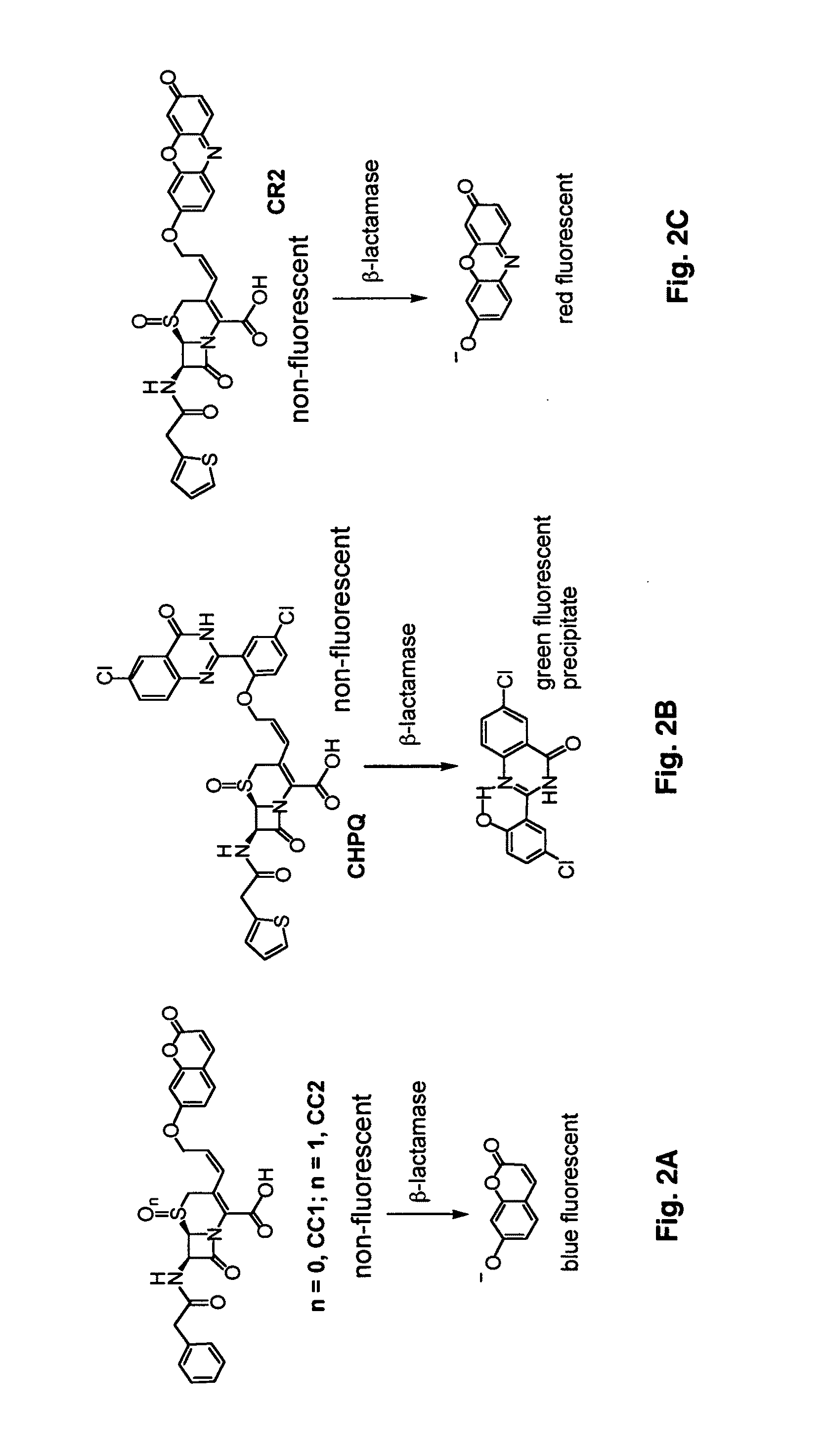Use of bacterial beta-lactamase for in vitro diagnostics and in vivo imaging, diagnostics and therapeutics
a technology of beta-lactamase and in vitro diagnostics, applied in the field of pathogenic microorganisms and imaging technologies, can solve the problems of difficult diagnosis of many of these infections, inability to detect penicillin resistance, and inability to quantify and assess the current methods of quantifying and assessing the viability of tuberculosis in the laboratory, can only be used to determine the colony forming units (
- Summary
- Abstract
- Description
- Claims
- Application Information
AI Technical Summary
Benefits of technology
Problems solved by technology
Method used
Image
Examples
example 1
Detection of Bla in M. tuberculosis in Culture
[0094]Potential fluorogenic substrate compounds and known compounds, including Nitrocefin (Calbiochem), CENTA Bla substrate (Calbiochem), Fluorocillin Green (Molecular Probes), CCF2-AM (Invitrogen) and CCF4-AM (Invitrogen), are compared for detection of Bla in Mtb using whole cells and whole cell lysates grown to early log-phase. Dilutions are assayed for all of these samples to determine the minimal number of bacteria or amount of lysate that results in significant signal. Titers are carried out to determine the number of actual CFU used, before and after assays with intact cells and before lysis for lysates. Both the sensitivity and reproducibility are evaluated in quadruplicate spectrophotometrically using 96-well plates incubated at 37° C. in bacterial culture medium from 15-120 min. Initially, compounds are used at concentrations recommended by the manufacturer and for CNIR5, 2 nM, i.e., that used for in vivo imaging. Different conc...
example 2
Intra-Vital Microscopy Imaging Using the Cell Transplantation Model
[0113]Universal donor Tr, CD8+ T cells, monocytes, macrophages and dendritic cells are transplanted into syngeneic mice infected with BCG, and the distribution of these cells over time are imaged with in vivo bioluminescence imaging (BLI) and image-guided intravital microscopy (IVM). A line of transgenic mice in which luciferase is produced by the beta-actin promoter, provide a source of tissues and cells that will emit light in non-transgenic animals (11-12). This mouse line (L2G85), shows bright bioluminescence from the firefly luciferase (Fluc), but weak GFP fluorescence, so it was mated with a separate line exhibiting strong GFP expression and fluorescence in lymphocytes. The spatial distribution of universal donor stem cells and other cells can thus be followed by BLI in the recipient as they expand, re-distribute or are cleared, and the cells detected can be subsequently visualized by IVM utilizing GFP.
[0114]Th...
example 3
[0120]Crystallization of M. Tuberculosis Blac and Blac Mutant Enzymes
[0121]Very good crystals of BlaC were obtained after a few months of crystallization. Co-crystals with penicillin were produced using crystallization conditions of 0.1M Tris-Hcl, pH 8.0, 20.M NH4H2PO4. These crystals allowed visualization of the intact protein active site and intermediate, but the initial bound substrate was not visible due to turnover in the crystal itself. To overcome this barrier, a Mtb BlaC mutant enzyme was constructed with the mutation in the Glu residue involved in hydrolysis (E166A) that allows trapping of the acy-intermediate on the enzyme and visualization of the specific interactions required for catalysis. This mutant has now been crystallized with a rapid, i.e., about two weeks, crystallization process yielding high quality crystals of Mtb BlaC mutant that are ready to be soaked with substrate (FIG. 1A). It is demonstrated that substrate can be incorporated into the Mtb BlaC mutant cry...
PUM
| Property | Measurement | Unit |
|---|---|---|
| emission wavelength | aaaaa | aaaaa |
| emission wavelength | aaaaa | aaaaa |
| imaging wavelength | aaaaa | aaaaa |
Abstract
Description
Claims
Application Information
 Login to View More
Login to View More - R&D
- Intellectual Property
- Life Sciences
- Materials
- Tech Scout
- Unparalleled Data Quality
- Higher Quality Content
- 60% Fewer Hallucinations
Browse by: Latest US Patents, China's latest patents, Technical Efficacy Thesaurus, Application Domain, Technology Topic, Popular Technical Reports.
© 2025 PatSnap. All rights reserved.Legal|Privacy policy|Modern Slavery Act Transparency Statement|Sitemap|About US| Contact US: help@patsnap.com



